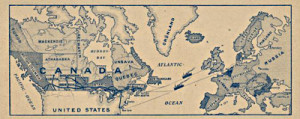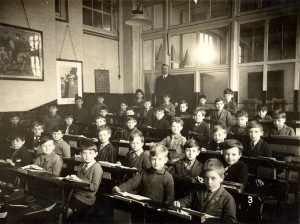Jim Ingram (b.1912): Education and Schooling
Both during and after the war Jim Ingram’s family, amongst many others, suffered from the weak economy caused by the war. This meant a lot of moving around for Jim and his mother, all around England and then to Canada, causing the unstable living arrangements to have a huge impact on Ingram’s education. Despite this, Jim struggles past his lack of education and strives to make a comfortable life for himself and his family.

Ingram first attended school when he moved from ‘the quiet Suffolk countryside’ (5) to ‘the noise and bustle of a crowded city– London’ (5). He explains how he had to adjust to the different lifestyle of the city including having to ‘learn to go to school’ (5). His first experience of school and teachers was not a positive one: ‘Once I spilled ink over my new copy book and discovered that for this offence the teacher would strike you on the hand with a piece of stick known as the cane’ (6). The punishment children faced during this time is shocking to read about when considering the consequences a teacher would suffer in this decade for committing such an offense on a child. Ingram allows us to see the development of education and the importance placed on it since the war.
The disability Ingram suffered with his leg and later on his failing eyesight, lead to a gateway of bullying during his time at school ‘At one school, the bigger boys, lacking a football to kick around, kicked me instead’ (7). The bullying affected him so much that eventually he stopped attending school at all ‘I stopped going to school, but nobody bothered’ (7). The lack of concern for his disrupted education highlights the lack of importance working class people put on education, perhaps because they thought they could not move up in society anyway so there would be no point or perhaps because the negative aspects of the war had distracted everyone from the importance of children getting an education.
Brian Ward has explained that ‘Impaired vision is one of the most common disabilities, and for many people it is the easiest to overcome’ (16) however, ‘for some, the defect is so severe that they can see only very poorly’ (16). This was the case for Ingram as he had to return to school after the war when he and his family moved to Canada. Ingram expresses his discontent that he ’had to go to school’ (12) and due to his failing eyesight, he was in a ‘special class for handicapped children, for as well as a lame leg I was now suffering from failing eyesight’ (12). This only fuelled his hatred for school more as he felt ‘inferior’ (14) to the other children.

Despite Ingram having a disrupted and negative educational experience, it did not stop him for having a passion to learn ‘Yet even as lameness and failing eyesight were making my life more and more impossible, I was developing ambitions’ (14). Instead of letting his disability hold him back, he used it to push himself which sometimes ended badly but gave him a sense of accomplishment anyway ‘in such ways I proved to my own satisfaction that I was as capable as any other boy’ (15). He gave up on school and pursued his ambitions to explore the world instead: ‘I seemed to see the Earth spread out before me like a map.. I wanted to explore them all’ (20) to engage his interest in history and geography and to prove to his father that he ‘could accomplish something’ (20).
Bibliography
The Autobiography of the Working Class: An Annotated, Critical Bibliography, ed. by John Burnett, David Vincent and David Mayall (Brighton: Harvester, 1984, 1897, 1989) 3 volumes, 2:430.
Ingram, Jim. A Wartime Childhood. Brunel University. 1987.
Ward, Brian. Overcoming Disability. Scholastic Library Publishing. 1989.
Image reference: (Accessed 2/11/2015)
Image reference: (Accessed 17/11/2015)

Leave a Reply